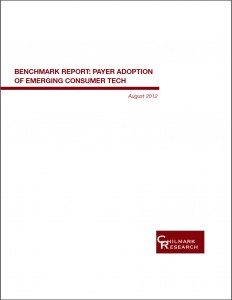 Health payers and plans are realigning their business operations to get closer to consumers. Anticipating the impact of the Affordable Care Act (ACA), coupled with the continuing trend toward consumer-driven health plans, Chilmark Research published the 2012 Benchmark Report: Payer Adoption of Emerging Consumer Tech in August 2012. John Moore, industry analyst and founder of Chilmark, and I had an email exchange to discuss the report.
Health payers and plans are realigning their business operations to get closer to consumers. Anticipating the impact of the Affordable Care Act (ACA), coupled with the continuing trend toward consumer-driven health plans, Chilmark Research published the 2012 Benchmark Report: Payer Adoption of Emerging Consumer Tech in August 2012. John Moore, industry analyst and founder of Chilmark, and I had an email exchange to discuss the report.
JSK: Why is this topic so timely now?
JM: Payers have been trying for years to engage their members with less than stellar results. The advent of new consumer technologies such as social media, mobile, games, and other platforms is an area where payers are increasingly looking into as a new path to engagement.
JSK: What is driving payers to seek greater consumer/patient engagement?
JM: The business of health and, in particular, health insurance is changing as a result of ACA and a future where insurers will be marketing to the individual and not just an employer. Insurers need to develop new methods of engagement to foster loyalty and of course, to encourage health behaviors to make wise health decisions.
JSK: What tools did payers adopt in this early phase that surprised you the most?
JM: We were surprised by the strong emphasis on gaming tech in early stages. There are still some development efforts here which has by and large been replaced by more “useful” transactional/educational solutions with some aspect of peer support.
JSK: Where are payers struggling with patient-facing technology? What can they do to overcome the obstacles?
JM: The biggest issue which has always plagued payers is summed up in one word: Trust. Most consumers simply do not trust health insurers to work on their behalf as there is a long history of denials. Another challenge has been payers’ hot and cold attitude towards these engagement programs – a lack of patience. They’ll start with some grand plan, invest significantly then not look long-term, expecting immediate results. They pull the plug [prematurely].
JSK: Are there characteristics shared by payers who are adopting consumer-facing tech compared to payers who aren’t?
JM: All have the same challenges with the changing healthcare landscape that they must address but beyond that, few common characteristics. There are simply those pushing forward to engage with new consumer technologies, with the majority that is still sitting on the sidelines.
JSK: What’s your forecast for the Tipping Point, when a plurality of payers will be using these tools as part of simply doing business?
JM: In our forecast, we estimate the tipping point will occur in 2015-6 when new reimbursement models really begin hitting their stride and payers increasingly align with (or acquire) providers and seek to better manage patient/member health outside the exam room.
Health Populi’s Hot Points: Chilmark has identified and described the first wave health plans and payers investing in consumer-facing health information technology. They have found that most payers are “waiting on the sidelines,” with a pioneering handful not only piloting consumer oriented tools but investing in or full-on purchasing start-ups in the field. An example of this would be Aetna’s work with iTriage.
Chilmark points to a critical obstacle for health plans in the consumer space: that is, dipping a toe in for the short-run, but withdrawing before consumers get the hang of engagement. Not taking a long(er) view is preventing these health plans from learning about how patients engage in health. Furthermore, by delaying such engagement, plans lack the dialogue with patients they need to have to develop a trusted relationship with these end-users of the plan. Moore rightly points out that health plans aren’t the most trusted nexus for health engagement. Only 38% of U.S. health consumers trust their health plans, according to Peppers & Rogers 2012 research, Measuring the Value of Trust in Healthcare, which I discussed in Health Populi in May 2012.
Health plans and payers don’t have to fully master consumer-facing health IT in 2012. But they’ll have to be masterful users of consumer health IT and tools by 2012 when the puck gets where it’s headed — when millions of consumers will be funded, empowered and charged with making decisions about health plans and clinical care.




 I'm in amazing company here with other #digitalhealth innovators, thinkers and doers. Thank you to Cristian Cortez Fernandez and Zallud for this recognition; I'm grateful.
I'm in amazing company here with other #digitalhealth innovators, thinkers and doers. Thank you to Cristian Cortez Fernandez and Zallud for this recognition; I'm grateful. Jane was named as a member of the AHIP 2024 Advisory Board, joining some valued colleagues to prepare for the challenges and opportunities facing health plans, systems, and other industry stakeholders.
Jane was named as a member of the AHIP 2024 Advisory Board, joining some valued colleagues to prepare for the challenges and opportunities facing health plans, systems, and other industry stakeholders.  Join Jane at AHIP's annual meeting in Las Vegas: I'll be speaking, moderating a panel, and providing thought leadership on health consumers and bolstering equity, empowerment, and self-care.
Join Jane at AHIP's annual meeting in Las Vegas: I'll be speaking, moderating a panel, and providing thought leadership on health consumers and bolstering equity, empowerment, and self-care.